
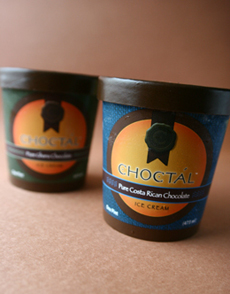
A new concept in superpremium ice cream: single origin chocolate ice creams from Costa Rica, Dominican Republic, Ghana and Kalimantan (Borneo).
|
KAREN HOCHMAN is Editorial Director of THE NIBBLE and loves to make ice cream in her spare time.
|
|
April 2007
Updated July 2009 |
 |
Choctál “Single Origin” Ice Cream
“Ultrapremium” Ice Cream With Beans From Different Countries
CAPSULE REPORT: The first line of “single origin” ice creams focusing on cacao beans and vanilla beans from different growing regions, Choctál is to be commended for creating something different in high-quality ice cream. Its debut products are single-origin chocolate ice creams with cacao beans from Costa Rica, the Dominican Republic, Ghana and Kalimantan (Borneo) plus a vanilla from Madagascar, to be followed by three other origin vanillas this summer. The challenge for the consumer is to decide what to do. Line them up and they do taste different; but are they different enough that most people would keep two—much less three or four—in the freezer? We don’t think so, but among the four choices, each person will have fun finding his or her favorite.
In the beginning there was ice cream, and—fast-forward ahead a few thousand years—when supermarket brands arrived in the 1950s, using cheaper ingredients and whipping more air into the product (known as overrun) to keep gallon prices low, it created a USDA classification system. “Economy,” “regular” and “premium” ice creams were defined by butterfat content and overrun. Häagen-Daz arrived in the 1970s with even higher butterfat and lower overrun, inaugurating the superpremium category. With butterfat greater than 14% (some brands have 18% and more), overrun as low as 20% and complex flavors in addition to the basic ones, there’s no place higher to go on the classification scale—by government standards, at least.*
*Read more about the differences in ice cream quality levels.
Yet, by marketing standards, there’s always someplace to go. Why be content with USDA-sanctioned “superpremium,” when your ice cream can lay claim to something that sounds even better? Choctál, a California company, ups the ante with its “ultrapremium” ice creams, which use ingredients that are more precious—single origin cacao and vanilla beans. Where most superpremiums use unspecific “cocoa” and “vanilla” bean (and in the case of chocolate, at least, is usually made from cocoa blended from beans of several origins, like blended wines), Choctál’s beans come from four different regions: Costa Rica on the Pacific Coast of Latin America, the Dominican Republic in the Caribbean, Ghana in West Africa and Kalimantan (Borneo), an island in the South China Sea that includes the nations of Indonesia and Malaysia and the Sultanate of Brunei.
The first three areas have been known for some time as producers of quality cacao beans, the best of which are made by some chocolate companies into single origin chocolate bars. Madagascar, along with Tahiti (the costliest) and Mexico, grow the best vanilla beans in the world. When you purchase “pure vanilla” extract, the beans are likely none of these unless so designated on the bottle. While the company won’t be making a Tahitian Vanilla immediately, Madagascar (an island in the Indian Ocean off the southeast coast of Africa) will soon be joined by vanilla ice creams from Costa Rica, Mexico and Papua New Guinea, the world’s second largest island, located in the Pacific Ocean just north of Australia.
Photo: A Madagascar Criollo cacao tree with
unripe pods, courtesy of Amano Artisan
Chocolate.
|
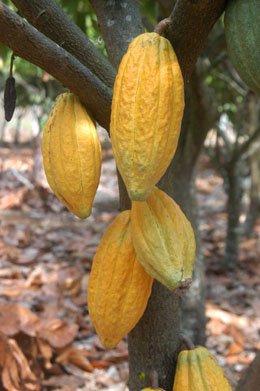 |
While Choctál may be the innovator with its line of single origin ice creams, other artisan ice cream-makers have produced high-end products with noteworthy cacao. For years, Dr. Bob’s Handcrafted Ice Cream of California has been making a line of superb chocolate ice creams using different percentages of Scharffen Berger chocolate; we have occasionally found a “Venezuelan Chocolate” at an ice cream boutique. Yet, no matter how much panache is put into the pint and whether it sells for $10.00 rather than $3.50, the USDA still classifies it as superpremium.
About Single Origin Cacao
Those who follow gourmet chocolate are familiar with single origin cacao (also known as origin cacao, pure origin cacao, mono-origin cacao, etc.). As with grapes, coffee beans and other agricultural products, it’s the concept that beans grown in one particular area or region—and the chocolate made from these beans—have distinctly different characteristics based on soil, microclimate, seasonal growing conditions and processing. Thus, generally speaking:
- Cacao grown on Madagascar, in the Indian ocean—often the Criollo bean—is vibrant with a crisp citrus acidity. It can yield flavors of grape, pineapple, cranberry and other red fruits.
- Ghana-grown cacao is bold, assertive and full-bodied. Most of it is the hardy Forastero bean, but the bitterness level of the Ghana Forasteros is relatively low. It’s also strongly chocolaty, with notes of coffee and tobacco.
- Caribbean cacao is predominantly the Trinitario bean, a natural hybrid of the Criollo and the Forastero. It can be light-to-medium on the palate with a unique Caribbean gentleness. While the cacao is not overly complex, there are many growing regions among the islands that can deliver every type of flavor, from fresh dairy, woody and grassy notes to wood, spice and tropical fruits.
These are the qualities that can be found in a bar of chocolate, when the cocoa mass has been mixed with cocoa butter to create a solid, intense mouthful of flavor. Connoisseurs of chocolate go from bar to bar to experience the myriad of flavors produced from beans in different growing regions, in different seasons and processed by different producers, each of which has its own recipes (see the wide range of flavors from cacao beans).
But what happens when the cocoa butter has been removed, the “press cake” has been ground into cocoa powder, the cacao flavor is diluted by milk and cream and further dulled through freezing? Can you still have a “single origin” experience?
The answer is yes and no. The four chocolate ice creams crafted by Choctál certainly taste different from each other, but by definition the experience is less intense—and therefore, we’d argue, less sensuous and thought-provoking—than the single origin experience of chocolate bars. But there’s no doubt that Choctál’s ice creams are made from the highest quality ingredients, and that any lover of chocolate ice cream would be glad to sit down with all four and experience the differences. At the end of the day, a chocolate bar-lover will re-purchase all four single origin bars and continue to enjoy reliving the single origin flavors. We think at the end of the day, the Choctál purchaser will decide on a favorite origin and stick to it.
 By the way, Choctál’s name is a combination of xocolatl (pronounced sho-KLA-til), the Mayan word for chocolate, and Tikal, a former major Mayan metropolis. The Company had a Mayan scholar create a hieroglyph for “Choctál” that is prominently featured on its packaging. By the way, Choctál’s name is a combination of xocolatl (pronounced sho-KLA-til), the Mayan word for chocolate, and Tikal, a former major Mayan metropolis. The Company had a Mayan scholar create a hieroglyph for “Choctál” that is prominently featured on its packaging.
Choctál Ice Cream Flavors: What’s Different
Each of the four Choctál single origin chocolate ice creams has a unique flavor profile, and, in order to highlight the regional differences, a lower amount of sugar and more cocoa powder is used in the recipe than in most other ice creams. There’s also a lot of vanilla (Madagascar), which is intended to highlight the cacao (chocolate ice creams generally do not include vanilla). The overall result is an especially creamy, ganache-mousse profile—the creaminess of which is dreamy, but actually undermines the intensity of the cacao. Based on the concept of the line, we anticipated a severity of cacao. No: These are flavors that can be enjoyed by anyone, from kids to connoisseurs.
To provide a benchmark and check on cacao content and density, we brought in pints of two small-batch, handmade gelatos: Il Laboratorio del Gelato’s Dark Chocolate, and Capogiro’s Cioccolato Oscuro, Boulder Ice Cream’s Chocolate. Gelatos are famous for more density and intensity of flavor; Boulder is a line which we have found to be also less sweet and very creamy. Here’s what we found:
- The density of Choctál is similar to Boulder and other superpremium ice creams in our experience. For $6 a pint, a typical cost for artisan products, you get a very high quality ice cream.
- Choctál does, however, have more cocoa powder in its recipes: The cacao stands out—you can taste it (in a good way). In the other brands, it’s more integrated into the overall recipe. That’s neither good or bad—it’s just the unique difference.
- Choctál’s higher percentage of vanilla—top-quality Madagascar vanilla, at that—and its greater creaminess, give the chocolate flavors a distinctly different “creamy” profile, as you’ll see in the notes below.
Chocolate
The four chocolate flavors are distinctly different, but in subtle ways, as four blended hot chocolates would be different. The challenge as a consumer is—and we have been going over this again and again in the month that we have been tasting these ice creams—how meaningful are these differences? The four varietals are different, yet very similar in profile, such that if we were going to have more than one chocolate ice cream in the freezer, it would probably be a different brand with a very different style.
Therein lies the 64 million cacao bean question: After we taste all four and decide which one we like best, will we go back to buy the other three? Would most restaurants carry more than one of the varietals? We don’t think so. It’s not like choosing among First Growth Bordeaux, when today you want Lafite, tomorrow Mouton, the next day Latour and the day after that, Cheval Blanc: The differences just aren’t that distinct. The analogy is to being in a development kitchen, tasting different batches that are all good, and deciding which way to go.
|
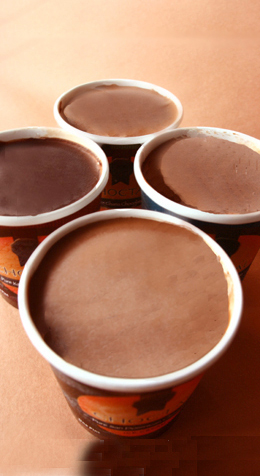
You can tell the different origins by the colors. |
We’re enchanted enough by our own experiments to want to serve a “quadruple chocolate” dessert of our favorite Choctál plus Capogiro, Il Laboratorio and Dr. Bob’s Scharffen Berger Really Dark Chocolate, a fudgy and chewy style compared to Choctál’s creamy, vanilla-and-mousse emphasis.*
*Other chocolate ice creams, including the artisan brands mentioned above and Häagen-Dazs®, do not include vanilla; Choctál includes it in each of its chocolate flavors.
Costa Rican, for example has lingering flavors of coffee and caramel, while Ghanaian has a full-bodied milk chocolate character with a hint of tropical fruit and an undertone of sweet fudge.
- Ghana is the lightest in color, a cinnamon nose with espresso notes. Fudgsicle®-like in personality (the Company calls it more milk chocolate-like), it is appealing.
- Costa Rican, our personal favorite, was the second-lightest in color: a coffee nose and lighter coffee notes on the palate combined with hints of sour cream, deep toffee and an olive note, reminiscent of the Pacuare bean from Costa Rica.
- San Dominican, from the Dominican Republic, is creamy and ganache-like. We picked up some clove and nutmeg notes, and the overall flavors coincidentally reminded us of the fine Felchlin chocolate bars we had tasted the prior week. Although one of the two darker shades, it not as intensely chocolate as the lighter two.
- Kalimantan, the deepest color, ironically seemed to be least cacao-intense. We found some tea, tobacco and smokiness, but kept coming back to this flavor, hoping to get more. The island whose colonial name is Borneo is home to East Malaysia, Indonesia, and the Sultanate of Brunei, does not have a high profile in the world of single origin cacaos: We’ve never had a chocolate bar with Kalimantan beans, but will keep an eye out to get to know this origin better.
Flavor: Vanilla
We really like this vanilla ice cream. It tastes like a true artisan product, something that the pastry chef at a fine restaurant would create. Triple vanilla Madagascar extract† is added mixed with lots and lots of vanilla bean specks. The tiny specks are crunchy, providing added texture to the ice cream—which, by the way, is not of the mousse-ganache style of the chocolate ice creams, but its own regal style. Be sure to try it—even if it doesn’t end up as your favorite vanilla of all time, you’ll respect the artistry of the product.
†This does not mean that the vanilla is three times as good as other Madagascar vanillas, but that the extract has been reduced so that it has three times the strength of a standard extract—thus, less of it is used in the recipe. Double-distilled and triple-distilled extracts are often used in fine professional products.
Vanilla lovers take note: In July, the company will introduce three new single origin vanillas, from Costa Rica, Mexico and Papua, New Guinea. We look forward to seeing the differences. While the company led with what is probably the best for ice cream, Madagascar, and the costliest vanilla, from Tahiti, isn’t included, we can’t wait to see how the world’s third best vanilla bean, from Mexico, compares.
Most artisanal producers continue to work on their products to perfect the recipes. We think that Choctál has made an auspicious debut, and look for more creativity from their freezers.
In terms of how to guide readers, our second, sit-down tasting with the five pints led us to the same conclusion as when we first tasted quick spoonfuls: We love the concept, we’ll hold tastings for the enjoyment and edification of our guests, though we’re not likely to buy more than one origin of each flavor to keep in our freezer on a regular basis. There’s no obvious or arcane food pairing to be be made—e.g., this origin goes better with apple pie, that one better in a sundae—it’s just what you personally like.
But any way you scoop it, the new line is good news for ice cream lovers.
CHOCTÁL™ SINGLE ORIGIN ICE CREAM
CHOCOLATE: Costa Rican, San Dominican (Dominican Republic), Ghana, Kalimantan
VANILLA: Madagascar; coming in July, Costa Rican, Mexican, Papua New Guinean
- Pint
$5.99
Suggested Retail Price
Available at Whole Foods Markets and other fine retailers.
For more information visit
Choctal.com
|
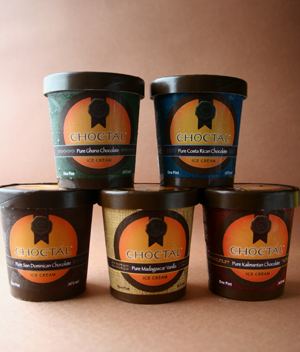 The Choctál Single Origin Family: four chocolates and a
vanilla, with more vanillas to come. The Choctál Single Origin Family: four chocolates and a
vanilla, with more vanillas to come.
|
Make Ice Cream Sandwiches
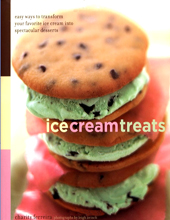 |
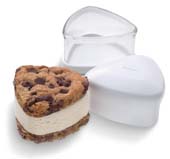 |
|
| Ice Cream Treats, by Charity Ferreira. Recipes, a buying guide and tips on the basics, such as softening and shaping ice cream. The book also contains recipes for homemade ice cream in traditional flavors like coffee, dark chocolate and vanilla bean. Click here to purchase or for more information. |
Cuisipro Ice Cream Sandwich Maker. Take your favorite cookies, your favorite ice cream, and create... heaven. Make perfectly-formed ice cream sandwiches every time. Click here to purchase or for more information. |
|

|






 By the way, Choctál’s name is a combination of xocolatl (pronounced sho-KLA-til), the Mayan word for chocolate, and Tikal, a former major Mayan metropolis. The Company had a Mayan scholar create a hieroglyph for “Choctál” that is prominently featured on its packaging.
By the way, Choctál’s name is a combination of xocolatl (pronounced sho-KLA-til), the Mayan word for chocolate, and Tikal, a former major Mayan metropolis. The Company had a Mayan scholar create a hieroglyph for “Choctál” that is prominently featured on its packaging. 


